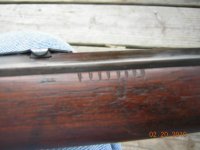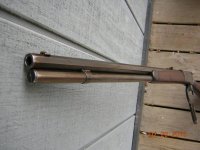I wonder which brass that the Rossi 92 with the 'brass' frame is made of? There are MANY different alloys of brass.....
Brass types
1. DZR brass is dezincification resistant brass with a small percentage of arsenic.
2. Gilding metal is the softest type of brass commonly available. An alloy of 95% copper and 5% zinc, gilding metal is typically used for ammunition "jackets", e.g. full metal jacket bullets.
3. High brass contains 65% copper and 35% zinc, has a high tensile strength and is used for springs, screws, and rivets.
4. Leaded brass is an alpha-beta brass with an addition of lead. It has excellent machinability.
5. Lead-free brass as defined by California Assembly Bill AB 1953 contains "not more than 0.25 percent lead content".[10]
6. Low brass is a copper-zinc alloy containing 20% zinc with a light golden color and excellent ductility; it is used for flexible metal hoses and metal bellows.
7. Manganese brass is a brass most notably used in making golden dollar coins in the United States. It contains roughly 70% copper, 29% zinc, and 1.3% manganese.
8. Muntz metal is about 60% copper, 40% zinc and a trace of iron, used as a lining on boats.
9. Nickel brass is composed of 70% copper, 24.5% zinc and 5.5% nickel used to make pound coins in the pound sterling currency.
10. Naval brass, similar to admiralty brass, is 40% zinc and 1% tin.
11. Nordic gold, used in 10, 20 and 50 cts euro coins, contains 89% copper, 5% aluminium, 5% zinc, and 1% tin.
12. Red brass is both an American term for the copper-zinc-tin alloy known as gunmetal, and an alloy which is considered both a brass and a bronze. It typically contains 85% copper, 5% tin, 5% lead, and 5% zinc. Red brass is also an alternative name for copper alloy C23000, which is composed of 14–16% zinc, 0.05% iron and lead, and the remainder copper. It may also refer to ounce metal, another copper-zinc-tin alloy.
13. Rich low brass (Tombac) is 15% zinc. It is often used in jewelry applications.
14. Tonval brass (also called CW617N or CZ122 or OT58) is a copper-lead-zinc alloy. It is not recommended for seawater use, being susceptible to dezincification.
15. White brass contains more than 50% zinc and is too brittle for general use. The term may also refer to certain types of nickel silver alloys as well as Cu-Zn-Sn alloys with high proportions (typically 40%+) of tin and/or zinc, as well as predominantly zinc casting alloys with copper additive.
16. Yellow brass is an American term for 33% zinc brass.
17. Admiralty brass contains 30% zinc, and 1% tin which inhibits dezincification in many environments.
18. Aich's alloy typically contains 60.66% copper, 36.58% zinc, 1.02% tin, and 1.74% iron. Designed for use in marine service owing to its corrosion resistance, hardness and toughness. A characteristic application is to the protection of ships' bottoms, but more modern methods of cathodic protection have rendered its use less common. Its appearance resembles that of gold.
19. Alpha brasses with less than 35% zinc, are malleable, can be worked cold, and are used in pressing, forging, or similar applications. They contain only one phase, with face-centered cubic crystal structure.
20. Prince's metal or Prince Rupert's metal is a type of alpha brass containing 75% copper and 25% zinc. Due to its beautiful yellow color, it is used as an imitation of gold. The alloy was named after Prince Rupert of the Rhine.
21. Alpha-beta brass (Muntz metal), also called duplex brass, is 35–45% zinc and is suited for hot working. It contains both α and β' phase; the β'-phase is body-centered cubic and is harder and stronger than α. Alpha-beta brasses are usually worked hot.
22. Aluminium brass contains aluminium, which improves its corrosion resistance. It is used for seawater service and also in Euro coins (Nordic gold).
23. Arsenical brass contains an addition of arsenic and frequently aluminium and is used for boiler fireboxes.
24. Beta brasses, with 45–50% zinc content, can only be worked hot, and are harder, stronger, and suitable for casting.
25. Cartridge brass is a 30% zinc brass with good cold working properties. Used for ammunition cases.
26. Common brass, or rivet brass, is a 37% zinc brass, cheap and standard for cold working.



